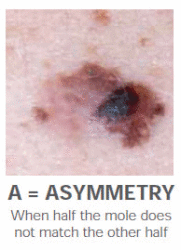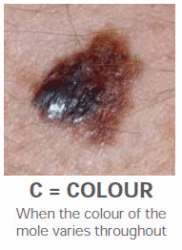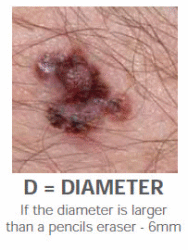Skin Cancer - Prevention is better than cure
An interesting subject was bought to my attention the other day; skin cancer or melanoma as it is often known. In the industry in which we work, there are many people who spend hours at a time outside so, are we at a higher risk of developing the disease?

I am sure we are all guilty of not wearing sun screen when out in the sun, but does it actually prevent our skin from being damaged as much as it states?
Well, not according to several recent reports which state that, despite there being a considerable increase in the amount of sunscreen being bought in recent years, the amount of people being struck by the most dangerous type of the cancer has increased by 2%.
To tackle this rise, the National Health Service (NHS) has dedicated pages of their website to displaying useful tips and information about over exposure to the sun and its potential dangers. They also simply explain signs to look out for so that symptoms may me diagnosed early.
The NHS website continues to explain that the simplest way to avoid skin cancer is to avoid overexposure to the sun. This is certainly an essential requirement if you have been treated for a melanoma before. However, it also recommends that you do not completely avoid the sun as it is a great source of vitamin D, which is important to maintain healthy bones.
One way to ensure a safe sun fix is to take regular breaks from direct exposure and don't go out in the peak times of the day, which is explained in more depth later in the article.
However, it is not just overexposure to natural sunlight which you need to limit. Sunbeds cause the highest percentage of skin melanoma in the UK. The British Association of Dermatologists advise highly against their use.
They explain that sunbeds are more dangerous than natural sunlight as they have a concentrated source of ultraviolet (UV) radiation being directly applied to the skin. In addition to melanomas, they also cause premature ageing of the skin. If, however, despite the high risks, you continue to use this sort of tanning equipment, the Health and Safety Executive (HSE) recommends that you do not use ultraviolet machines if:
- You have fair, sensitive skin that burns easily or tans slowly
or poorly
- You have a history of sunburn, particularly in childhood
- You have lots of freckles or red hair
- You have lots of moles
- You are taking medicines or using creams that make your skin
sensitive to sunlight
- You have a medical condition that is made worse by sunlight
- You have had skin cancer or someone in your family has had skin
cancer
- Sunlight has already badly damaged your skin
The HSE's list also gives advice on other important points to consider before using a UV machine. For example, a professional operator should be able to guide you on how many minutes you should spend in the machine depending on your skin type. A new rule has no also been introduced by the Sunbed Regulations Act 2011 stating that it is illegal for Under 18's to be:
- allowed to use tanning salons and sunbeds at premises
including beauty salons, leisure centres, gyms and hotels
- offered the use of a sunbed
- allowed to be in an area reserved for sunbed users
Looking again at natural exposure, what other ways can we protect our skin from sun damage?
Cancer Research UK has compiled a list of their top tips, including 'The Shadow Rule'. Although it sounds like a silly title, it may just be a brilliant way to help children stay safe when refusing to put on their sunscreen. The idea is that, if your shadow is shorter than you, then the sun is strong and it is best to stay in the shade until it becomes cooler.
The most dangerous time to be outside is when the sun is at its strongest between 11.00am and 3.00pm. However, if you like your sunbathing or work outside all day, then it is recommended that regular breaks are taken. For example, eat your lunch inside or sit under a parasol. These all give you 'skin breaks' from being exposed to direct sunlight.
It is also important to remember that it's not just sunbathing that will allow you to burn. You may think you are rushing around, so the sun won't catch you. Yet, the most common mistake people make is playing sport and thinking they won't get burnt. They will, so always take precautions to prevent this from happening. Another really important, but simple, way of staying safe is the clothing that you decide to wear.
These days you can stay safe, but still remain the height of fashion. Wearing things like a maxi dress, a long sleeved cotton shirt or a wide brimmed hat will keep you covered and protected but still cool in hot conditions - I am not suggesting some of those items for groundsmen and greenkeepers, but you get my drift.
What signs should you look out for?
Although many of us think 'oh, that wouldn't happen to me', it is always important to look out for signs. If you know you have spent increasing amounts of time in the sun, whether working or just sunbathing, the NHS recommends that everyone gives themselves a monthly head to toe examination for early signs that something is wrong. Melanomas can appear anywhere on the body, with the face being the most common area; they can even appear under fingernails.
Changes in your moles to look out for are:
- Getting bigger
- Changing shape, particularly getting an irregular edge
- Changing colour - getting darker, becoming patchy or multi
shaded
- Loss of symmetry - the two halves of your mole do not look the
same
- Itching or painful
- Bleeding or becoming crusty
- Looking inflamed
Research suggests that moles with three or more different shades
of brown or black are particularly likely to be a melanoma.
Normal moles are usually oval shaped and are not larger than 6mm in
size. Melanomas are usually irregular and larger than 6mm. It is
also recommended that, if you have a mole, it be checked first by a
doctor then, if you notice any changes afterwards, you know
something may be wrong.
Cancer research has also made up a simple rule to help remember these important signs - ABCD - Asymmetry, Border, Colour and Diameter.
 |
 |
Asymmetry: The two halves of a mole do not look the same.
Border: The edges of a mole are irregular, blurred or jagged.
Colour: The colour of a mole is uneven, with more than one shade.
Diameter: A mole is wider than 6mm in diameter (the size of a pencil eraser).
 |
 |
If you notice any of these signs, it is essential you visit your doctor. It may feel like a chore looking for changes, but skin cancers found and removed are almost always curable.
The topic of skin cancer has arisen a number of times on the Pitchcare message board and created very interesting discussion, with many employers saying that they feel a responsibility to provide their employees with sun block and other items, such as wide brimmed hats and plenty of water. They do say also, however, that it is very costly for them to keep providing these items and maybe a plan should be introduced whereby employees are initially provided with such items, but it then becomes their responsibility to provide their own sun protection. But, even then, it is up to the employee to actually put on the sun block and wear the hats, so it can be very difficult to enforce.
It remains a fact, though, that it is an employer's responsibility to keep staff who work outside for long periods of time safe in hot conditions.
People who are most at risk are those with pale skin; however, everyone should be taken into consideration. As an employer, it is essential that, during health and safety courses and training days, people discuss how to stay safe in the sun. Speak to your employees about how it can affect their health and reassure them that, by following simple steps, they can dramatically reduce their risk of developing skin cancer.
The most important point, however, is that you allow workers to take rests throughout the day where they are out of the sun completely.
Ensure they eat their lunch inside or allow them to take a break in a shaded spot. You should also ensure that there is a water source nearby to prevent dehydration.
By following these steps, you are allowing your workforce to remain healthy and reduce and prevent the risk of them developing skin cancer.
